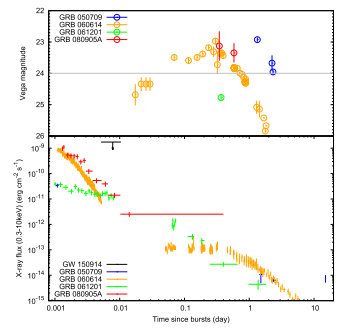It is predicted by the General Relativity that the speed of gravitational waves (GW) in the vacuum equals the speed of light. It is impossible to measure the speed of GW until they were detected directly for the first time in Sept. 2015. If the speed of GW is less than the speed of light, the current observations of ultra-high energy cosmic rays (UHECRs) request that their relative difference is less than 10-15. However, the speed of GW can be greater than that of light in many theories of GW, which are weakly constrained by observations. Therefore the direct measurement of the speed of GW has very important and fundamental impacts in science. Currently there are two main methods to measure the speed of GW directly. (1) The arrival time difference of GW signals among different GW detectors allows a direct calculation of the speed of GW, which, however, has a very low precision. (2) Based on the principle that, if the speed of GW is different from that of light, there should be an arrival time difference between a GW signal and its almost simultaneous electromagnetic radiation signal for a cosmological event, according to which one can obtain the upper limit of the speed difference between GW and light.     About 0.4 second after the successful detection of the first GW transient (GW150914) by the Laser Interferometer Gravitational-wave Observatory (LIGO) on Sept. 14, 2015, the Fermi Gamma-ray Burst Monitor (Fermi-GBM) revealed the presence of a weak gamma-ray transient lasting about 1 second. Despite some controversies, a special data analysis group of Fermi-GBM suggested this signal with a significance of 3σ, and it is very likely to be associated with GW 150914. Li X., Zhang F. W., Yuan Q. et al. carried out a deep discussion on physical implications of such an association immediately. Especially, they found that, if the speed of GW is greater than that of light, their relative difference should be less than 10-17 . If the association between GW 150914 and the gamma-ray signal from Fermi-GBM is real, it is the first accurate measurement of the velocity of GW. Even the length of this paper exceeds the limit of the Astrophysical Journal Letters (ApJL) significantly, the editorial office made an exception to publish this work (“For this exceptionally important work I am allowing you to exceed our nominal Letters length limits”). About 0.4 second after the successful detection of the first GW transient (GW150914) by the Laser Interferometer Gravitational-wave Observatory (LIGO) on Sept. 14, 2015, the Fermi Gamma-ray Burst Monitor (Fermi-GBM) revealed the presence of a weak gamma-ray transient lasting about 1 second. Despite some controversies, a special data analysis group of Fermi-GBM suggested this signal with a significance of 3σ, and it is very likely to be associated with GW 150914. Li X., Zhang F. W., Yuan Q. et al. carried out a deep discussion on physical implications of such an association immediately. Especially, they found that, if the speed of GW is greater than that of light, their relative difference should be less than 10-17 . If the association between GW 150914 and the gamma-ray signal from Fermi-GBM is real, it is the first accurate measurement of the velocity of GW. Even the length of this paper exceeds the limit of the Astrophysical Journal Letters (ApJL) significantly, the editorial office made an exception to publish this work (“For this exceptionally important work I am allowing you to exceed our nominal Letters length limits”).
The paper link is: http://iopscience.iop.org/article/10.3847/2041-8205/827/1/L16. This paper is also included in the ApJL collection on electromagnetic counterparts to binary Black Hole mergers (http://iopscience.iop.org/2041-8205/focus/Focus_on_BBHM). In spite of the debate of the nature of the Fermi-GBM signal, in a paper published in the Astrophysical Journal (ApJ) in Aug. 2016 (http://dx.doi.org/10.3847/0004-637X/827/1/75), Li X., Hu Y. M., Fan Y. Z. et al. figured out that the association between short gamma-ray bursts (SGRBs) and GW events are probably established in a few years, and hence the relative speed difference between GW and light is expected to be constrained to a precision of 10-18 (see Fig. 1). In this paper, for the first time, they proposed to directly and accurately measure the speed of GW and test the Einstein’s weak equivalent principle simultaneously. These two studies are supported by the 973 program of Ministry of Science and Technology of China (especially the young scholar program), National Natural Science Foundation of China (especially the Funds for Distinguished Young Scholars and the Key Project), and the Strategic Priority Research Program B of CAS. 
By with LI Xiang Fig. “Expected” afterglow emission of GBM transient 150914, which are “generated” from the R-band (upper panel) and X-ray (lower panel) afterglow emission of several nearby SGRBs. The modifications include the corrections of fluxes due to the distance and z shifts and the factor of ∼2 × 1049 erg/Eiso,i to roughly correct the difference arising from different Eiso (according to the afterglow model; Piran 2004; Kumar & Zhang 2015), where the subscript i represents a given GRB presented in the figure. The X-ray and optical afterglow data are taken from Fong et al. (2015). The 3σ upper limit of X-ray emission following GW150914 (Serino et al. 2016) is also marked. |
